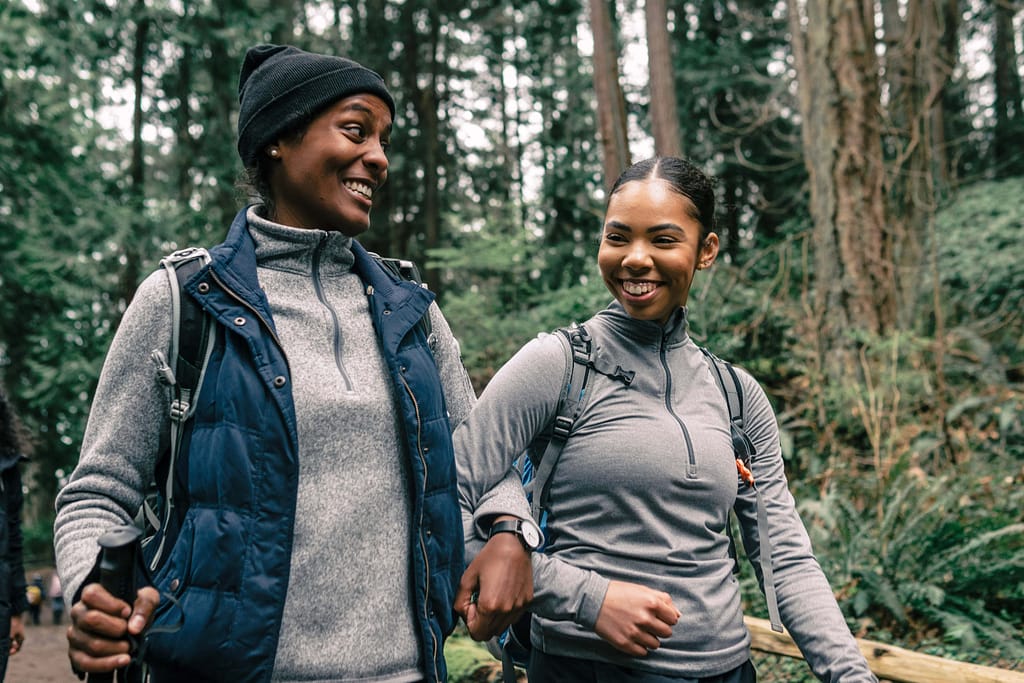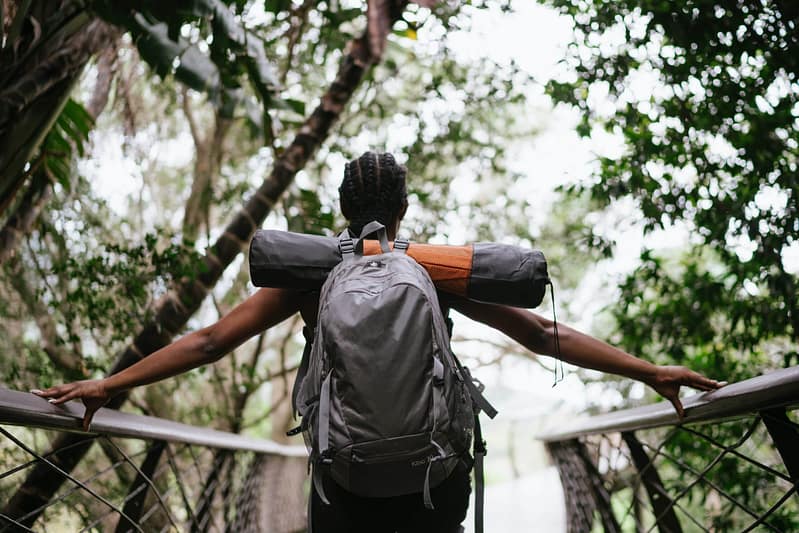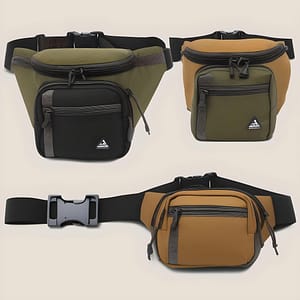Whoever said hiking couldn’t be a fashion statement clearly hasn’t met us, adventurous and fashion-savvy ladies! Gone are the days when hiking outfits were limited to ill-fitting cargo pants and shapeless t-shirts. It’s time to embrace the great outdoors with the right hiking outfit for women
How do I choose the right size for hiking outfits for women?
1. Embrace Your Measurements:
Okay, let’s start with the basics! Take out that trusty measuring tape, because it’s time to get up close and personal with your body. Measure your bust, waist, and hips, and keep those numbers handy. Remember, ladies, we’re all unique, so don’t be afraid to embrace those curves and celebrate them when choosing your hiking gear.
2. Beware of “One-Size-Fits-All”:
Ladies, we’ve all fallen for that “one-size-fits-all” trap, only to end up with sleeves that could double as leg warmers, or pants that are better suited for our pet cat. When it comes to hiking outfits, avoid this like a mosquito-infested trail. Look for brands that offer multiple size options, because let’s be real, we’re all beautifully different.
3. Apply waterproofing treatment:
Use a waterproofing spray or wax to treat your boots before you hit the trail. This will enhance their ability to repel water and keep their feet dry. Be sure to follow the manufacturer’s instructions for the best results.
What type of material is best for hiking outfits for women?
When it comes to choosing the best material for a women’s hiking outfit, there are a few key factors to consider – comfort, durability, moisture-wicking properties, and versatility. Here are some top materials to consider for your hiking ensemble:
1. Merino Wool:
Merino wool is an excellent choice for a hiking outfit, especially for base layers and socks. It is naturally moisture-wicking, which means it absorbs sweat from your skin and keeps you dry. Additionally, merino wool is known for its odor-resistant properties, making it ideal for multi-day hikes.
2. Synthetic Fabrics:
Synthetic fabrics such as polyester or nylon are popular choices for hiking outfits. They are lightweight, quick-drying, and offer excellent breathability. These materials are also durable and can withstand the rigors of hiking through rough terrains.
3. Nylon-Spandex Blend:
A nylon-spandex blend is often used in hiking pants and shorts. This combination provides flexibility, freedom of movement, and comfort during strenuous hikes. Look for materials with a high percentage of nylon for increased durability.
4. Moisture-Wicking Fabrics:
Hiking involves physical exertion, which leads to sweating. Opt for moisture-wicking fabrics that draw sweat away from your body, allowing it to evaporate quickly. This helps to regulate your body temperature and prevents discomfort.
5. Ripstop Nylon:
If you’re looking for a durable and tear-resistant material, ripstop nylon is an excellent choice. It is often used Ripstop nylon is an excellent choice for a hiking outfit, especially if you’re looking for durability and tear-resistance. This innovative fabric is often used in outdoor gear and clothing due to its incredible strength and longevity. Whether you’re tackling rugged terrains or bushwhacking through dense forests, ripstop nylon has got your back.
The unique construction of ripstop nylon involves weaving thicker threads into a crisscross pattern, creating a grid-like structure. This design helps to prevent tears and stops them from spreading. So even if you accidentally snag your outfit on a sharp branch or rock, the damage will be minimal thanks to this sturdy fabric.
What type of accessories should I bring for a hiking trip?
When embarking on a hiking trip, it is essential to pack the right accessories to ensure a safe and enjoyable experience in the great outdoors. Here are some must-have accessories to consider for your next hiking adventure:
1. Backpack:
Invest in a sturdy, comfortable backpack that can hold all your essentials. Look for one with padded straps and a hip belt for added comfort.
2. Hiking Boots:
A good pair of hiking boots with ankle support and a rugged sole is crucial to protect your feet and provide stability on uneven terrain.
3. Navigation Tools:
Bring a map, compass, or GPS device to help you navigate trails accurately. These tools are essential for staying on track and avoiding getting lost.
4. First Aid Kit:
Accidents can happen while hiking, so always carry a well-stocked first aid kit. Include bandages, antiseptic wipes, pain relievers, insect repellent, and any necessary personal medications.
5. Water Bottle and Water Treatment:
Staying hydrated on the trail is vital. Bring a reusable water bottle and consider carrying a water treatment method such as water filtration tablets or a water purifier for emergencies.
6. Snacks and Meals:
Pack energy-boosting snacks like trail mix, granola bars, and dried fruits. If you plan to have meals on the trail, bring lightweight, non-perishable options like dehydrated meals or ready-to-eat camping food.
7. Clothing Layers:
Dress in layers to adapt to changing weather conditions. When it comes to hiking, one of the most essential tips is to dress in layers. Mother Nature can be unpredictable, and weather conditions can change rapidly while you’re out on the trail. To ensure you stay comfortable and prepared for whatever comes your way, layering your clothing is key.
Start with a moisture-wicking base layer. This layer is designed to pull sweat away from your body, keeping you dry and regulating your body temperature. Look for materials like merino wool or synthetic fabrics that are breathable and quick-drying.
Next, add a mid-layer for insulation. This can be a lightweight fleece jacket or a down-filled vest. The purpose of the mid-layer is to provide warmth while still allowing for breathability. Consider the temperature and weather forecast when choosing the thickness of your mid-layer.
The outer layer, often referred to as a shell or shell jacket, is your first line of defense against wind, rain, or snow. Go for a waterproof and windproof shell that is also breathable. It should have taped seams and adjustable cuffs and hems to keep the elements at bay.
What clothing items should I wear for a hiking trip?
When it comes to a hiking trip, choosing the right clothing items is essential for both comfort and safety. Here are some key clothing items you should consider wearing:
1. Moisture-wicking base layers:
Start with a moisture-wicking base layer, such as a synthetic or merino wool shirt and underwear. These materials help to keep your body dry by wicking away sweat.
2. Hiking pants or shorts:
Go for lightweight, quick-drying pants or shorts that provide freedom of movement. Look for options with zip-off legs if you anticipate varying weather conditions.
3. Breathable hiking socks:
Invest in a good pair of hiking socks made from moisture-wicking and breathable materials. These will help prevent blisters and keep your feet dry and comfortable throughout the hike.
4. Sturdy hiking boots or shoes:
Choose footwear that offers ankle support and a good grip on various terrains. Make sure your shoes are broken in before the trip to avoid discomfort or blisters.
5. Moisture-wicking and breathable shirts:
Wear lightweight, breathable shirts that allow your skin to breathe. Long-sleeved shirts can protect you from the sun and insects, while short-sleeved shirts are suitable for warmer weather.
6. Insulating layers:
Depending on the climate and season, pack insulating layers like a fleece jacket or a down-filled vest. These layers will keep you warm in colder temperatures or at higher altitudes.
7. Waterproof and windproof outer shell:
Carry a waterproof and wind When hiking, it is crucial to have a reliable outer shell that is both waterproof and windproof. This essential piece of gear will protect you from unexpected weather conditions and keep you comfortable throughout your outdoor adventure.
A waterproof and windproof outer shell is designed to repel rain, snow, and strong gusts of wind. It acts as a protective barrier between you and the elements, keeping you dry and shielded from harsh weather conditions.

What type of footwear is best for hiking?
The right type of footwear you choose should provide comfort, support, and protection against the rugged terrain. Here are some options to consider for the best hiking footwear:
1. Hiking Boots:
Hiking boots are a popular choice for hikers due to their sturdy construction and ankle support. They are designed to handle various terrains and provide stability on uneven surfaces. Look for boots with a waterproof and breathable membrane to keep your feet dry and comfortable.
2. Trail Running Shoes:
If you prefer a lightweight option, trail running shoes can be a great choice for hiking. They are designed to be flexible, breathable, and provide good traction. However, keep in mind that they may not offer as much ankle support as hiking boots, so they are better suited for well-maintained trails.
3. Hiking Shoes:
Hiking shoes are a middle ground between hiking boots and trail running shoes. They offer some ankle support but with a lighter and more flexible design. Hiking shoes are suitable for day hikes on moderate terrains and can be a comfortable alternative if you don’t need the extra ankle support of boots.
4. Sandals:
For hiking in hot and dry climates or on water-based trails, hiking sandals can be a good option. They provide breathability and allow your feet to stay cool while still offering traction and protection. However, they may not be suitable for rocky or rugged terrains that require hiking in hot and dry climates or on water-based trails, hiking sandals can be a fantastic option. They offer breathability, keeping your feet cool and preventing excessive sweating. Hiking sandals also provide excellent traction and protection, allowing you to navigate through wet and slippery terrain with ease.
Hiking sandals are designed with durable and quick-drying materials, making them perfect for water-based adventures. They are built to withstand exposure to moisture and dry quickly, preventing discomfort and blisters caused by wet feet.

What should I do to keep my feet dry while hiking?
Hiking can be a wonderful and exhilarating outdoor activity, but it can also be quite challenging, especially when it comes to keeping your feet dry. Wet feet can lead to discomfort, blisters, and even foot infections. To ensure you have a pleasant hiking experience, here are some important tips to keep your feet dry while hiking.
1. Choose the right footwear:
Start by investing in a pair of waterproof hiking boots or shoes. Look for options that are specifically designed to keep your feet dry, with features like Gore-Tex lining or waterproof membranes. Make sure they fit well and provide adequate support.
2. Wear suitable socks:
Go for moisture-wicking socks made of materials like merino wool or synthetic blends. These types of socks are designed to draw moisture away from your skin, keeping your feet dry and preventing blisters. Avoid cotton socks as they tend to retain moisture and can make your feet more susceptible to getting wet.
3. Use gaiters:
Gaiters are protective coverings that go over your boots and provide an additional layer of protection against water, mud, and debris. They help prevent moisture from seeping into your boots from the top, keeping your feet dry and clean.
What precautions should I take to protect myself from the sun while hiking?
Hiking under the scorching sun can be both enjoyable and challenging. However, it is crucial to prioritize your safety and protect yourself from the harmful effects of the sun’s rays. Here are some precautions you should take to safeguard yourself while hiking:
1. Wear appropriate clothing:
Go for lightweight, loose-fitting, and light-colored clothing that covers as much skin as possible. Long-sleeved shirts and pants made from breathable fabrics provide better protection against the sun. Additionally, consider wearing a wide-brimmed hat to protect your face, neck, and ears.
2. Apply sunscreen:
Before heading out, generously apply a broad-spectrum sunscreen with a high SPF (Sun Protection Factor) of at least 30. Don’t forget to cover all exposed areas of skin, including your face, ears, neck, and hands. Reapply the sunscreen every two hours or more frequently if you are sweating heavily or swimming.
3. Seek shade:
Whenever possible, take advantage of shaded areas along your hiking route. Plan your breaks, rest stops, and lunch breaks in shaded spots to minimize direct exposure to the sun. This will not only protect you from the sun’s harmful rays but also provide some relief from the heat.
4. Time your hikes wisely:
Aim to start your hikes early in the morning or later in the afternoon when the sun is not at its peak intensity. This will help you avoid prolonged exposure to strong sunlight and reduce the risk of heat-related illnesses.
hiking outfit for women: Conclusion
Hiking is about more than just the destination; it’s a chance to connect with nature and embrace your adventurous spirit. And just because you’re out in the wilderness doesn’t mean you can’t do it in style! With fashionable and functional outfits, you can conquer any trail with confidence and a sense of humor. So, fellow hiker gals, let’s hit the trails and show the world that hiking and fashion can go hand in hand.





